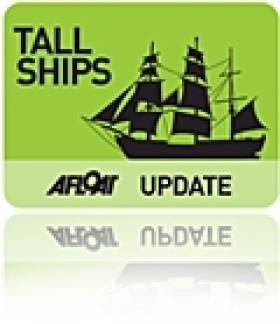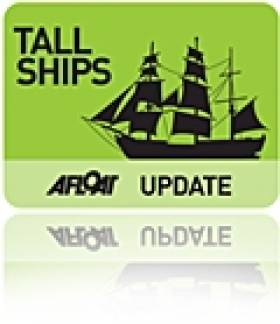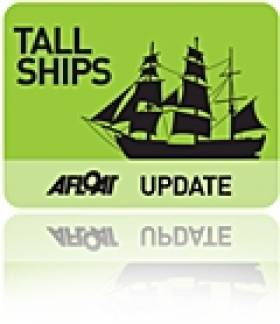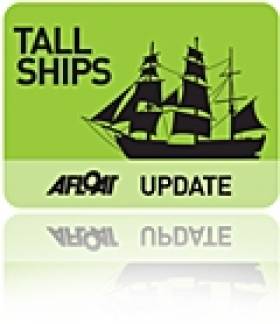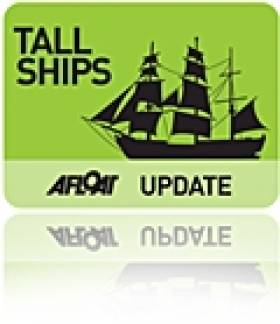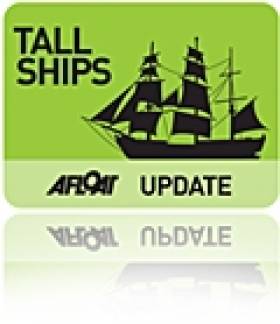Displaying items by tag: Tall Ships
Hamburg Gets Ready to Host World's Biggest Ports Festival
Billed as the world's greatest Port Festival, five of the world's largest and most beautiful tall ships – and at least one, the Mir, is also entered for the Tall Ships race in Waterford in June – have announced their presence at Hamburg next month.
Also coming to Hamburg is the Dar Mlodziezy, the Kruzenshtern, the Mir, the Sedov and the Sea Cloud. Each of these classic sailing ships, at home on the oceans of the world, is more than 100 metres in length, and captures the romance of maritime life.
The HAFENGEBURTSTAG HAMBURG has a thing or two to show off about given its large fleet of boats and Tall Ships that are gathering this year for the 822nd time. It's an opportunity to for Irish port festivals aiming to exploit the marine leisure resources around the Irish coastline.
The Sea Cloud, built in Kiel in 1931, and the largest private yacht in the world at the time, will be present at HAFENGEBURTSTAG HAMBURG for the first time, back in Hamburg for the first time in 33 years.
In Hamburg, there will be tall ships and cruise vessels, naval ships and emergency service boats, heritage and museum ships, sailing and motor yachts, dragon boats, and even a Roman galley. Altogether more than 300 vessels from the seven seas will be taking part, on display in their element before the fantastic backdrop of Hamburg's Landing Stages (Landungsbrücken) from 6 to 8 May at the world's greatest Port Festival.
The port is more lively than ever on the three days of HAFENGEBURTSTAG HAMBURG", says Captain Jörg Pollmann, in eager anticipation. "All those different ships and displays on the Elbe combine to form a unique celebration, which brings more than a million visitors to the Port of Hamburg every year." The guests from Germany and abroad can look forward to a superlative programme on the water, starting with the Grand Arrival Parade from 16:30 on Friday 6 May, and ending with the Grand Departure Parade at 17:30 on Sunday 8 May. There are also plenty of maritime attractions at the Oevelgönne Heritage Harbour and at the HafenCity traditional maritime harbour.
Meeting of the luxury liners
Visitors are warned that watching the six cruise ships arriving and departing on the three days of HAFENGEBURTSTAG HAMBURG may cause itchy feet and severe travelitis! The AIDAcara, AIDAblu and Mein Schiff 2 will be arriving on the Friday, the Amadea and the Fram, an expedition ship from Norway, will follow on the Saturday. And to top it all, the Queen Mary 2 will call in Hamburg on the Sunday. Costa Crociere, Europe's largest cruise ship operator, has just chosen Hamburg as the new home port for its cruise ship Costa Magica, and will join in the celebrations, sponsoring the great Costa Cruises Firework Display at 22:30 on Saturday 7 May, lighting up the night sky over the Elbe.
International navy visit and maritime adventurer from Norway
The world's greatest Port Festival traditionally brings a large naval contingent from Germany and elsewhere to Hamburg. From Germany there will be the frigate Sachsen, the fast patrol boat Hermelin and the mine hunters Homburg and Hameln. Norway, the partner country of HAFENGEBURTSTAG HAMBURG, will be represented by the frigate Otto Sverdrup, and Belgium by the mine hunters Crocus and Primula.
Norway, the partner country for this year's HAFENGEBURTSTAG HAMBURG, is also sending vessels of various designs and uses to visit Hamburg. The Arctic sailing ship Berntine will welcome visitors on board in the HafenCity Traditional Harbour. She was built at the Tromsøer shipyard in 1890 and restored several times since then. Sjøkurs is a training ship, built by the Hamburg shipyard Blohm & Voss in 1956 as the Postal Vessel Ragnvald Jarl. Today she accommodates 60 cadets on board, and travels around Norway and to other countries about ten weeks per year. The Fram, an expedition ship, will moor at the Hamburg Cruise Center in HafenCity. She is the latest addition to the Hurtigruten fleet and was christened by Norway's Crown Princess Mette Marit on 16 May 2007.
On duty for safety and security
The challenges of work on the high seas will be demonstrated by a range of modern working vessels from the fire services, fisheries protection, THW emergency services, the waterways police and the customs. The rescue cruiser John T. Essberger, owned by the German Lifeboat Institution DGzRS, will make its final appearance at HAFENGEBURTSTAG HAMBURG before decommissioning. It will then start on its final voyage to the Technical Museum of Speyer, where it will in future be moored as a museum vessel.
Dancing tug boats and heritage ships
One of the traditional highlights of the maritime programme is the unique Tug Boat Ballet at 17:00 on the Saturday, when the 5000 hp working tugboats perform their pirouettes on the Elbe.
A fleet of classic steamships will give a special birthday greeting from the Oevelgönne Heritage Harbour when they pass the Landing Stage at 16:00 on the Saturday, "full steam ahead" – not only puffing out clouds of smoke from their chimneys, but also releasing balloons from their decks.
On-board visits
Many of the vessels at HAFENGEBURTSTAG HAMBURG, including the tall ships and naval units, will hold Open Days for visitors to look around on board. Many of the launches and passenger ships also invite visitors to HAFENGEBURTSTAG HAMBURG to go on board and join in the Parades, or to tour the vessel.
Sail Training Ireland to be Launched Next Week
Since the Department of Defence declared they no longer had an interest in sponsoring the continuation of the Asgard Sail Training Programme, and the subsequent decision of the Board of Asgard to wind up the Company, a working group supported by the ISA has worked to establish a National Sail Training Association.
Sail Training Ireland for Youth Development Ltd. has been established as a limited company recognised by Sail Training International as the representative body for Sail Training activities in Ireland.
An objectives of the organisation is to promote the development and Education of young Men and Women on the Island of Ireland in and through the Sail Training Experience regardless of Nationality, Culture, Religion, Gender or Social Background.
Bursaries Announced as Tall Ship Sailing Creates a Buzz
There's a real sailing buzz around Tall Ships these days, even though Ireland does not currently have one to sail. There's less than 100 days to the Tall Ships visit to Waterford, last weekend saw a ground breaking Tall Ships Conference, a sailing School has offered a Sloop as a temporary replacement and this morning the Irish Sailing Association has announced 1000 Euro bursaries to get young people involved in Tall Ship sailing.
Last weekend's workshop in Dublin Port was a great success with Tall Ship Chairmen from Dublin, Belfast, Cork and Galway all in attendance. Now the ISA is going on further with the immediate announcement of the launch of Sail Training Ireland, again in Dublin Port in two weeks time.
Following the sinking of the Asgard II and the decision to wind up Coiste An Asgard, the ISA (Irish Sailing Association) has facilitated a steering group with the establishment of 'Sail Training Ireland', an umbrella organisation developing a national sail training programme in Ireland. Sail Training Ireland, now incorporated as a limited company, is to be launched on Thursday the 14th of April 2011 in Dublin Port offices at 12:30pm. All those with an interest in Sail Training activities are very welcome to attend.
Sail Training International has awarded a bursary to Sail Training Ireland which will provide funding to support the participation of young people in The Tall Ships Races 2011 and 2012. Sheila Tyrrell, Chair of the steering group, who has a long history with sail training and in particular the Asgard remarked "We are delighted that we are in a position to formally launch the association, we are now taking applications for bursaries to allow young people to participate in the Tall Ships Race visiting Waterford later this year, and are also recruiting a manager to help manage the affairs of the association."
The aims and objectives of Sail Training Ireland are to promote the development and education of young men and women through the Sail Training experience regardless of nationality, culture, religion, gender or social background as well as to sponsor and support sea-going trainees. Sail Training Ireland will also engage with Sail Training International to establish a recurring Sail Training Ireland endorsed Tall Ships Maritime Festival every three to five years.
There will be a number of bursaries of up to a maximum of €1,000 available, towards the cost of the voyage. Each bursary shall not be more than 50% of the total cost of participation i.e. cost of the berth plus any travel expenses. Applicants should apply in writing using the application form published on www.irishsailtraining.com . Applications must be received by 30 April 2011.
Sail Training Ireland is also seeking to appoint a part-time manager to help with the development of a business plan and the day to day running of the organisations affairs. Further information on the position and a full job description can be found on the STI website www.irishsailtraining.com. Closing date for applications is Friday 22nd April, just three weeks away.
The launch, sponsored by Arklow Shipping, is to be hosted by Dublin Port who are one of a number of ports supportive of the project.
Looking for further reading on Tall Ships in Ireland? Click the links below:
Click this link to read all our Tall Ships Stories on one handy page
Previewing Ireland's Tall Ships 2011 Season
Can Ireland Get a New Tall Ship?
West Cork School Offers Temporary Tall Ship Sloop Solution
"There was fantastic energy at the Tall Ships workshop and while it was agreed that Ireland would benefit tremendously from an iconic square rigger tall sihip, this will take some to bring to fruition.
In the meantime, we are can look to existing Tall Ships operating with Irish Flag to offer the great experience that Sail Training can offer. Rohan MacAllister, previously captain of Asgard II for 10 years attended the meeting with Gail & Niall MacAllister of West Cork Sailing Centre to present Cypraea as a marvelous tall ship sailing sloop that is equipped to provide sail training on our Irish waters this summer.
The attendees of the meeting congratulated the MacAllisters on their tenacity and determination in bringing their sail training vessel to our waters and making the "Sail Training Experience" accessable for teenagers and adults this summer by dedicating July to Teenage Sail Training 5 day adventure sails for 350 euro and August to Adults at 450 euro.
Cypraea is a 23.5m steel sloop with berths for 10 at present and plans to increase to 16. She has three sails and is an extremely hands on team work sailing experience.
West Cork Sailing have been providing ISA and RYA sailing for many years and are excited to be providing Sail Training and the amazing life changing opportunity that it can bring".
Looking for further reading on Tall Ships in Ireland? Click the links below:
Click this link to read all our Tall Ships Stories on one handy page
Previewing Ireland's Tall Ships 2011 Season
Can Ireland Get a New Tall Ship?
Tall Order for Ireland
Sailing in Ireland could yet have a tall ship to replace the Asgard II and the Lord Rank. A meeting in Dublin in late March represents a major step forward in the process to put an Irish tall ship back on the high seas.
The open workshop, to be held on March 26th, will be facilitated by Dublin Port, and will include state interests, tourism interests, commercial port interests, youth organisations, maritime organisations and education groups, together with the former Lord Rank and Asgard II operators.
The catalyst for the initiative is a 'reference group' which represents a broad cross-section of interests, both North and South. Operating under the chairmanship of Lord Glentoran, and supported by Dr Gerard O'Hare, David Beattie and Enda O'Coineen, the group has also engaged a professional consulting firm to move the process along.
The initial focus is on the necessary organisation and rationale behind building a new vessel, while scientifically quantifying the benefits to build a plan and justification.
The view taken is that, while there may be no money available at this time, there is no excuse for not having a plan and the idea is to create ' joined-up' thinking. And while the government in the South placed the insurance money paid out on Asgard II back into general exchequer funds, the insurance payment on the Lord Rank was kept and ' ring-fenced' for this new initiative.
To date, there have been several meetings of the reference group. The planned workshop on the subject at Dublin Port March 26 is open and interested parties are invited to contribute. It will also bring together for the first time the leaders of Tallships in Dublin, Belfast, Waterford and Cork.
Ultimately Tall Ships is about youth training and development; without an active Tall Ship, it will be very difficult for Ireland to attract Tall Ship events. The new reference group will work to support the new Sail Training Ireland Association initiative, and link in with Sail Training International which runs Tall Ship events.
Following the Dublin workshop, Belfast Harbour Commissioners will host a working meeting of the group in early May to finalise a plan, present to stakeholders and create a roadmap forward.
"In addition to youth training, a working Tall Ship forms a brilliant ambassadorial role promoting tourism, enterprise and commercial interests," said Lord Glentoran. "It is something that we can all relate to and it has universal acceptance for youth training on an island of Ireland basis." Lord Glentoran has a long commitment to youth sail training and was Chairman of the organising committee that brought the Tall Ships to Belfast in 1991.
The reference group is seeking to engage with as many stakeholders as possible, and has pledged that the new vessel will be owned by the community in Ireland and the Irish Diaspora. The initial view is that the project clearly needs to be linked with the institutions of State - North and South - as are universities state agencies and ports, while at the same time having a strong private support network making for a mix of public and private funding, "We now have a brilliant opportunity to look around the world, establish best practice in the best kind of vessel, how to fund it and to quantify the benefits for each of the stakeholder group," said Enda O'Coineen, who has been instrumental in bringing the group together. In addition to being a former Coiste and Asgard Director, he is the founding Chairman of Let's Do It Global, which brought the Volvo Ocean Race to Galway and successfully raced the Green Dragon around the world.
O'Coineen added that a "world class solution" can be created and that its benefits can be financially quantified, which would allow supporters to make a compelling business case to divert and use existing funds in Tourism, Enterprise and Youth Training. "While there is no money available now to support the scale and professionalism needed, this is not an excuse not to have a plan and a vision," he added.
Since the loss of the Asgard II and Lord Rank, Ireland has been left with no sail training opportunities for young people and likewise for maritime development, enterprise and tourism. If nothing is done, future generations will suffer. The reference group believes that the solution is the construction of an Ireland - North and South - training vessel, fulfilling several roles with a common mission and resourced according to quantifiable benefits delivered to stakeholders. It is also open to the use of an existing vessel - a key component being suitability and the operations budget.
The proposed Tall Ship project will enhance skills and opportunities for young people across the island, regardless of background, class or education. It could be used to showcase Ireland as a brand at overseas events and it could also host international students who wish to come to the island of Ireland, as is the case with many of the International Tall Ships Programmes already running on a global scale which create a huge amount of tourism for their respective countries.
The reference group notes that the Tall Ships concept appeals to young and old alike as the romanticism behind the concept touches on history, social studies, legacy, family, travel, adventure and, most importantly, fun. Tall Ships allow people to dream. They do however have an underlying seriousness and the concept is grounded in methodology that has been tested and proven the world over.
An advertisement in March/April of Afloat magazine - out now - gives full detials of the 'Tall Ship for Ireland' Workshop
Should Ireland be represented at the Tall Ships Races at Waterford 2011 and Dublin 2012? We want your vote on our Facebook Poll HERE.
Looking for further reading on Tall Ships in Ireland? Click the links below:
Click this link to read all our Tall Ships Stories on one handy page
Previewing Ireland's Tall Ships 2011 Season
Tall Ships Ireland
The four-day sailing spectacle will descend on the 'noblest' quays in Europe on the last day of June (June 30th - July 03rd 2011). Click here for all the latest news on Tall Ships in Ireland.
The event is expected to draw over 500,000 maritime and music fans to Ireland's oldest city with visitors from home and abroad sharing the cosmopolitan atmosphere with sailors young and old from all corners of the world on the quays built on the foundations of the city's Viking settlements.
After the hugely successful inaugural hosting of the Tall Ships Race in 2005, Waterford has the skills and capacity to repeat its success. The opening of the Tall Ships is always a draw and is part of the festive party programme which will also celebrate Irish and continental acts in street theatre, firework-displays, music and food.
Most importantly for younger Tall-Ship lovers, there are opportunities for 16 year-olds to take part as a trainee from Waterford to Greenock in Scotland (departing July 3, 2011) as part of the first leg of the 2011 race. The cost is approximately €750 to include accommodation on the ship prior to and during the race to Greenock as well as the flight back to Ireland.
Without doubt the highlight will be the 'Parade of Sail' on July 3, when the Tall Ships head downriver from the River Suir, through Waterford estuary and out to the open sea. From there the tall ships will race off the western seaboard bound for Scotland. Later, there will be a cruise-in-company from Greenock to Lerwick in the Shetland Isles. The second race in the series will then go from Lerwick to Stavanger, Norway from where the third and final race will bring the fleet to Halmstad, Sweden.
Unlike 2005, there will be no Asgard II to lead the parade of sail, though since the sinking of the brigantine and the decision to wind up Coiste An Asgard, the Irish Sailing Association (ISA) has been facilitating a steering group with the aim of establishing 'Sail Training Ireland'.
The new body has been working with Sail Training International STI (the organisers of the Tall Ship Races) to establish a sail training programme with trainee providers and host ports. In the meantime, STI has awarded a bursary to Sail Training Ireland which will provide funding to support the participation of young people in the Tall Ships Races 2011 and 2012.
Looking for further reading on Tall Ships in Ireland? Click the links below:
Click this link to read all our Tall Ships Stories on one handy page
Can Ireland Get a New Tall Ship?
Will Sail Training Be Restored?
I am glad to see that efforts are being made to restore the national sail training programme, but less sanguine about reposing any confidence in the present Government to give practical assistance.
I talked a few weeks ago with the Irish Sailing Association's Chief Executive about their involvement in moves to establish a new sail training organisation to replace Coiste an Asgard, which the Government abandoned. Harry Hermon told me that the ISA had been examining the possibilities of what could be done. They were providing a forum which has now led to the setting-up of a steering group aimed at establishing a new organisation, Sail Training Ireland.
Sail Training International which organises the Tall Ships Races has given support. The Tall Ships Race will start from Waterford Port next year and is due into Dublin in 2012.
Nigel Rowe, Chairman of the international body, has expressed confidence that the current moves will result in a plan to continue sail training in Ireland. Sail Training International has awarded a bursary to the emerging Irish organisation, providing financial support for young Irish sailors in the 2011 and 2012 races.
The ISA working group says it will make a formal launch of its plans in the next few weeks. At present it is putting together a feasibility study and a business plan which will be presented to the Government in the New Year.
While the ISA move is welcome, I wonder about the value of presenting a plan to the existing Government which destroyed sail training, abandoned Asgard II on the seabed off France and used the insurance compensation money for purposes other than sail training.
I understand that other groups, who may differ with the ISA approach, have been planning their own moves in sail training and that the ISA decided to establish its position in public first.
It also has to be noted that there was criticism of the former Coiste an Asgard committee which did not make any moves in public to oppose the Government closure, on financial grounds, of the sail training programme.
It would be regrettable if differences delayed positive developments, but a united approach, involving the widest possible support to the restoration of sail training would be best.
• This article is reprinted by permission of the EVENING ECHO newspaper, Cork, where Tom MacSweeney writes maritime columns twice weekly. Evening Echo website: www.eecho.ie
Irish Sailing and Boating Regattas and Maritime Events
Reporting on the latest race news and regatta information is the one of the most important aspects of the Afloat.ie website. This page covers everything from round the world race stopovers, the arrival of the Tall Ships as well as domestic boat shows and a calendar of events.
Volunteer Falls to Death on Tall Ship
A 68-year-old sailing volunteer fell to his death over the weekend from the yardarm of a tall ship. Gregory Vance Gushaw was preparing the Star of India, a 205-foot windjammer, to set sail when he slipped off his spot on the rigging, falling 50 feet and hitting a shroud before plunging into the water. Attempts to revive him failed and he was pronounced dead on arrival at hospital.
The boat was docked in San Diego, where it is owned by the San Diego Maritime Museum, of which Gushaw was a trustee.
The Star of India is considered the oldest working sailing boat afloat, built in 1863 in the Isle of Man.
Looking for further reading on Tall Ships in Ireland? Click the links below:
Click this link to read all our Tall Ships Stories on one handy page
Previewing Ireland's Tall Ships 2011 Season
Can Ireland Get a New Tall Ship?
Lord Nelson Pays Dun Laoghaire a Visit
The Lord Nelson struck a lovely sailing pose crossing Dublin Bay this week. The disabled sail training vessel berthed overnight in Dun Laoghaire Harbour and Gareth Craig photographed her leaving. Images on the gallery now.
Looking for further reading on Tall Ships in Ireland? Click the links below:
Click this link to read all our Tall Ships Stories on one handy page
Previewing Ireland's Tall Ships 2011 Season
Can Ireland Get a New Tall Ship?



























